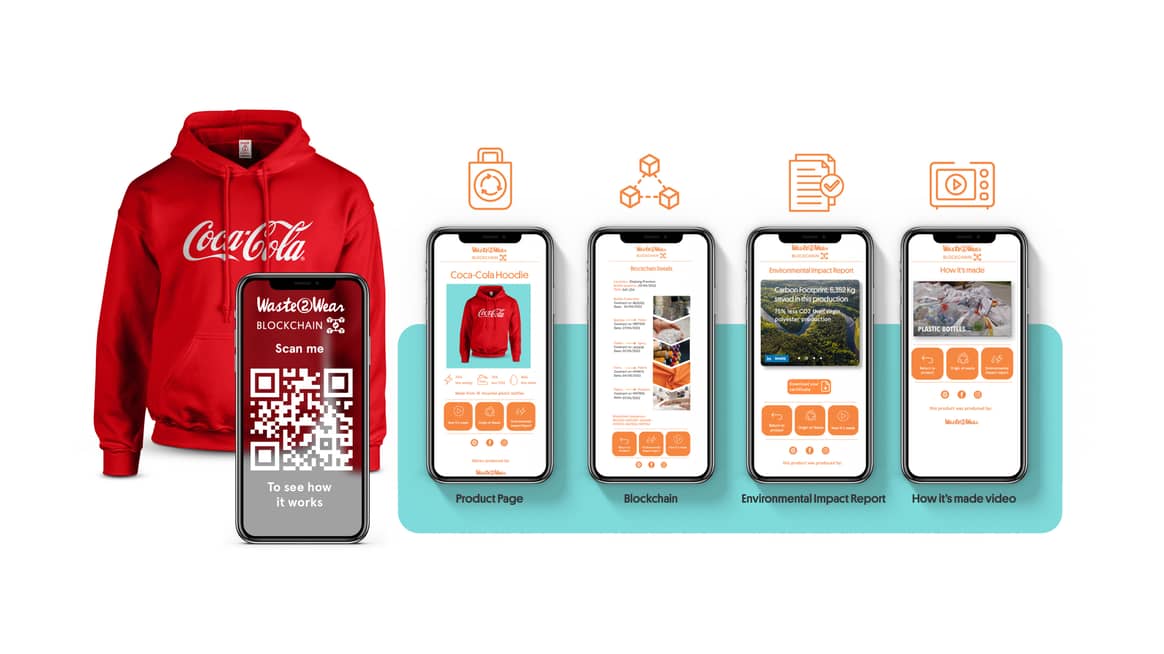Engaged in the clothing industry for 20 years.

From Fridge to shopping bags thanks to award-winning blockchain technology from Waste2Wear
Transparent supply chains seem to be becoming the new normal in the fashion industry. However, if you really want to produce sustainably, you need to know where your materials come from and flow to. This challenge is new to many companies, but there are also players in the market who worked very early on the digital tools that will soon become indispensable. Waste2Wear belongs to that club. With its award-winning blockchain technology, the Dutch company has been providing insight into the circular journey of plastic waste for fifteen years, so that the steps are traceable, measurable, and verifiable. Fashion United talked to founder and CEO, Monique Maissan.
Track the blockchain
FIFA World Cup backpacks, Coca-Cola hoodies and Mars shopping bags are just a few of the recycled goods that Waste2Wear can produce transparently. “We supply innovative textile products made from recycled plastic.” Maissan begins, “and we do this completely transparently and traceably through unique blockchain.” By linking physical plastic waste from, for example, refrigerators or plastic bottles on the one hand and digital, logistical information on the other, customers can monitor the entire production process.
The recycled plastic textile products that Waste2Wear makes do not originate from within the textile sector. Basically, two types of waste streams are processed through mechanical and chemical recycling. We are talking about plastic from the inside of a refrigerator, washing machine or food container that is transformed into post-consumer recycled polypropylene (RPP). “We use that to make a lot of shopping bag for very big brands.” assures Maissan. And then there are other plastics from plastic bottles, for example, to make recycled polyester (RPET) for clothing, sports bags, chair covers or curtains etc. Fabric to fabric is also possible with the help of partners in Italy and America. They can reduce textile products to the building materials of polyester and are currently preparing to set up a factory to turn the end-of-life RPP bags into reusable recycled pellets for further, repeat use.
Never be cheated again
Waste2Wear’s technology guarantees safety and openness in the supply chain by giving a complete passport to every type of waste used. These recycled pellets and bales are given stickers and locks with a unique QR and barcode on them, that are updated with new information with each scan: a combination of a geolocation with coordinates, time, weight, the person or organization performing the job with a certificate and finally a photo. Everything is put together in a smart contract. Maissan says: “It is a whole combination of security systems to verify exactly what raw material of the products is used in the supply chain – whether that is a piece of plastic, a thread, a fabric or a T-shirt.”
Maissan points out that without such an extensive information flow, blockchain technology misses the mark. “You get more and more companies that offer traceable options with certificates, but what it really comes down to is charging for a digital version of a paper trail. Of course, you can upload everything in a blockchain, but you could also photoshop that information. This system is more than a picture, it uses unbreakable locks and keys to secure the amount throughout the supply chain. That is why it has won us several international awards.”
Because you can really track that a material comes from a legitimate waste management company, it is not possible to cheat. Maissan states. “It not only assures you that you are making things from recycled plastic, but also that your supply chain is fully compliant. It is also a good check on social compliance.” The CEO aims to prevent unethical practices, such as illegal forms of subcontracting where plastic waste is collected by non-certified parties.

Visual impact
A very valuable extra is the environmental information and impact report (EIR) that customers receive for each product in their order. Plastic recycling has a much lower environmental impact than the production of virgin materials and companies want to communicate this honestly. Maissan: “Some of our customers said that they choose our recycled fabrics because they know what they saved compared to a virgin alternative via the Waste2Wear EIR. This also helps them reach some of their SDGs and address a host of new carbon neutral schemes. It is important to be able to calculate how much Co2 is used in production.”
Via Life Cycle Assessments (LCA), Waste2Wear can calculate how much Co2 is used per recycled plastic product. “We recently add this information to each product,” says Maissan. “That is very cool, because if you order it from a company that specializes in LCAs, it will cost you around €20,000 each time. To raise the transparency bar even higher, an explanation video is provided with each step: It shows how a refrigerator actually comes apart and how it is made into something new.
Clients are plentiful – from Mars to Coca-Cola to Fabienne Chapot. This also means that new employees are also very welcome. “We need a lot of people and we are a very cool, green company close to Amsterdam, says Maissan. The door is therefore wide open to professionals with a passion for honest fashion and tech.


